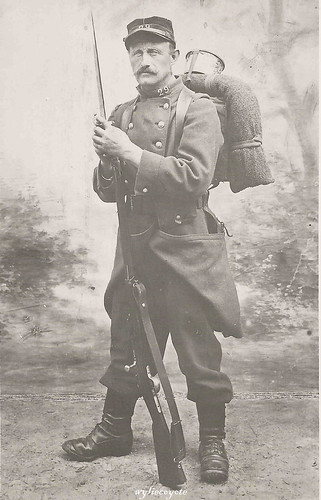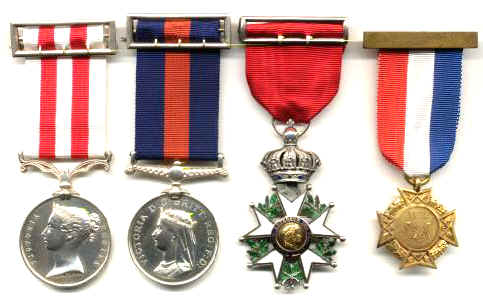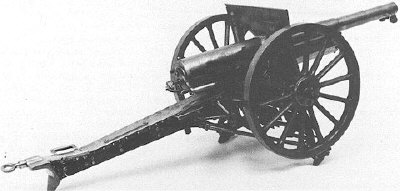
A very peaceful nation, few would guess that The Free Land of Carbonne would have a military. However, since 1910, a small, all-volunteer national defense army has been scooping up the ruffians, criminals, adventurers, and patriot sons that Carbonne has to offer, turning them into some of the finest soldiers around.
At the recruiting station, few questions are asked about why one wants to join. If you are a male, at least 17 years old and in good health, your chances of being rejected for service are extremely low. Recruitment numbers can fluctuate wildly, usually with economic downturns or sweeping waves of patriotism that occassionally grip even the overwhelmingly liberal Free Land. Nevertheless, in order to be considered for enlistment, all potential recruits must be in a reasonably healthy condition, be able to read and write at an secondary school level, perform five press-ups, ten sit-ups, and 3 pull-ups.
One may enlist under an "assumed identity" (a false name) for any reason, but usually only if they are on the wrong side of the law or escaping a disastrous love affair. Enlistment contracts begin at four years, but six-, eight-, and ten-year contracts also exist, each with their own increase in pay and other benefits. Potential recruits are very clearly warned that under Carbonnian military law, desertion is prosecuted as treason, a capital offence, and therefore the punishment is death. If there are no further issues, the enlistee signs his contract, opens his own military bank account to begin recieving pay, and starts his illustrious military career.
Once the recruit has "signed his life away", he will depart for the nearest staging center, usually a local garrison. At the staging center, he is monitored closely, given routine medical examinations, and performs menial tasks or janitorial work. A poor attitude, the discovery of a serious medical condition, or even the most minor misconduct during this stage may result in a discharge without pay. Normally, meagre pay is recieved during this time (50 francs a day) and the potential recruit has access to on-base military stores.
As soon as there are enough recruits assembled at the staging center (usually fifty or so) they are formed into a temporary unit and sent to the training camp. When they arrive, they officially are given the rank of Engagé Volontaire and recieve a 5 franc pay increase.
During the first week, recruits are issued the equipment they will use during training; their uniform (including ammunition belt, haversack and kepi), their rifle, bedroll, eating tin, boots and a multitude of other items like razors, towels, etc. They are taught how to use their military bank account, told what is expected from them during training, told what the rules and regulations of the army are, then given a guided tour of the training camp. The focus of the first week is to make sure the recruits are prepared for their training; little discipline or physical activity takes place.
The second week of training can be a harsh wake-up call for some. They are woken early on Monday morning and told that they have lost all their rights. They are told they must earn these rights back through hard work, discipline and exemplary performance. Instead of the cafeteria-style food the first week, the new recruits are switched to combat rations and begin their intensive physical training regimen. Instead of sleeping comfortably in barracks, they are forced to pitch tents and sleep in a large open field. They do not even have names at this point: they are given (usually derogatory or embarrassing) nicknames by their Sergents. They are taught how to march, basic parade positions, saluting, military ranks, and how to operate and clean their rifle. Physical discipline is common and many of the weaker recruits may "break" during this first week.
In order to earn the right to be called by their names during the third week, a recruit must:
1. Pass 3 of 5 of the uniform inspections.
2. Pass this week's academic examinations.
3. Perform 25 press-ups, 40 sit-ups, and 5 pull-ups.
4. Score at least a 50 out of 100 on their first marksmanship test (Man-sized target, 10 rounds, 20 meters).
If a recruit fails any of these requirements, they are "reverted" and must re-take the second week of training.
The third week of training focuses on physical training. Recruits must complete a massive obstacle course, complete with multitude of low crawl obstacles, low walls, small tunnels, rope and ladder climbs, monkeybars, a bayonet target course, and several cooperative "team" obstacles. The course focuses on confronting recruit's weaknesses and fears (heights, the dark, confined spaces, water, etc). Forging bonds of teamwork and cooperation are considered this week's secondary goals.
In order to earn the right to sleep in the barracks during the fourth week, a recruit must:
1. Pass 3 of 5 of the uniform inspections.
2. Pass this week's academic examinations.
3. Perform 35 press-ups, 50 sit-ups, and 7 pull-ups.
4. Score at least a 60 out of 100 on their second marksmanship test (Man-sized target, 20 rounds, 30 meters).
If a recruit fails any of these requirements, they are "reverted" and must re-take the third week of training.
The fourth week of training represents a turning point in the recruits' lives: they have earned back half the rights they have lost and now are progressing on their way to becoming full-fledged soldiers. This week of training presents an increased challenge to the recruits. Marksmanship, weapon cleaning and maintenence are drilled endlessly. Uniforms and barracks inspections are expected to be perfect.
In order to earn the right to eat in the cafeteria during the fifth week, a recruit must:
1. Pass 4 of 5 of the uniform inspections.
2. Pass 4 of 5 of the barracks inspections.
3. Pass this week's academic examinations.
4. Perform 40 press-ups, 60 sit-ups, and 10 pull-ups.
5. Score at least a 80 out of 100 on their third marksmanship test (Man-sized target, 30 rounds, 50 & 70 meters).
If a recruit fails any of these requirements, they are "reverted" and must re-take the fourth week of training.
The fifth week of training is mainly an administrative and competitive stage: recruits are told which unit they will be reporting to, what assignment they will recieve, and prepare for their final tests. A comprehensive, strenous academic test consisting of 100 questions is given during this week, as well as a challenging marksmanship course. Recruits must pass both of these to become soldiers, but recruits who display exemplary service may be qualified to recieve the rank of Fantassin de première classe (Infantryman First Class), which is an honorary title that designates exceptional peformance during basic training and gives the soldier a pay increase over others (an extra 20 francs a day).
In order to earn the right to graduate during the sixth week, a recruit must:
1. Pass all of the uniform inspections.
2. Pass all of the barracks inspections.
3. Pass the final academic examination.
4. Perform 50 press-ups, 70 sit-ups, and 15 pull-ups.
5. Score at least a 85 out of 100 on their final marksmanship course (varying target sizes and distances)
If a recruit fails any of these requirements, they are "reverted" and must re-take the fifth week of training.
The sixth and final week of training is very relaxed, focusing around camaraderie and graduation. Dress uniforms are issued, ranks are distributed, medals are presented in ceremonies throughout the week. Overall it is a very exciting time for the new soldiers. Finally, with their friends and family watching, the newly-promoted Infantrymen march out onto the parade ground in their full dress uniforms, some proudly sporting the red chevron of the Fantassin de première classe. The commanding officer of the training camp and the Major of the training unit both deliver a speech about the class and recognize those with the best academic, physical fitness and marksmanship scores. The names of all the men are read in roll call fashion. At the end of the ceremony, the men are ordered to report to their respective postings, give a final mass salute, and the training unit is officially dissolved. This can be quite emotional, even for the most hardened of recruits, as they have come to have made great friends in the past six weeks. However, their careers in the army are just beginning.
Military Ranks, Uniforms and Insignia
Officiers supérieurs:
Général de Brigade (4 Silver Stars)
Colonel (3 Silver Stars)
Lieutenant-Colonel (2 Silver Stars)
Commandant (1 Silver Star)
Officiers subalternes:
Capitaine (2 Gold Bars)
Lieutenant (1 Silver Bar)
Sous-Lieutenant (1 Gold Bar)
Aspirant (No Insignia)
Sous-officiers:
Major (Four Yellow Chevrons)
Sergent Chef (Three Yellow Chevrons)
Sergent (Two Yellow Chevrons)
Militaires du rang:
Caporal Chef (Three Red Chevrons)
Caporal (Two Red Chevrons)
Fantassin de première classe (One Red Chevron)
Fantassin (No Insignia)
Engagé Volontaire (No Insignia)
Carbonnian soldiers' units are displayed through the use of stamped metal collar numbers rather than patches and other insignia, with the number-letter combination representing the regiment and section they are attached to (23A = 23rd Regiment, A Company).
Uniform for Officers.

Uniform for Enlisted and NCO's.

Military Decorations

At the date of this publication, there are only four medals that are issued to Carbonnian forces: (from left to right)
1. The Joan of Arc Medal - Awarded for the highest order of bravery and conspicuous service at significant risk to life and limb. Awarded for actions that exemplify the Carbonnian soldier and the noble ideals which support him.
2. The Saint Maurice Medal - The patron saint of infantrymen, the Saint Maurice medal is awarded for soldiers who perform their duties as an infantryman above and beyond the call of duty. Usually awarded for acts of gallantry which do not involve serious risk to one's life.
3. Long Service Medal - Awarded for ten year's satisfactory service in the Carbonnian Army.
4. National Service Medal - Awarded for four year's satisfactory service in the Carbonnian Army.
Military Weapons and Equipment

(The above image is of my own creation, please do not plagiarise my work or modify it without my permission.)
Name: Fusil Mle 1925 M75
Country of Origin: Carbonne
Manufacturer: Manufacture d'Armes de Lyons
Calibre: 7.5x54 French Service
Rifling: 4 grooves, right hand
Length: 1295mm
Weight: 4.28kg
Barrel: 800mm
Feed System: Non-detachable box magazine, loaded individually or stripper-clip fed.
Magazine Capacity: 10 rounds
Operation: Straight-pull bolt action
Muzzle Velocity: 823mps
Sights: Rear: Ladder; graduated from 100m to 1500m. Front: hooded fixed post.
Effective Range: 800m

(The above image is of my own creation, please do not plagiarise my work or modify it without my permission.)
Name: Modèle 1925 Revolver
Country of Origin: Carbonne
Manufacturer: Manufacture d'Armes de Lyons
Calibre: 9×29R
Rifling: 7 grooves, right hand
Length: 286mm
Weight: 1.09kg
Barrel: 152mm
Feed System: Break-Open Cylinder
Cylinder Capacity: 8 rounds
Operation: Double Action / Single Action Revolver
Muzzle Velocity: 305 mps
Sights: Rear: Notch. Front: Fixed post
Effective Range: 30m

The Thompson M1921 is a new breed of weapon known as the "submachinegun". Firing the heavy-hitting .45in cartridge from 50-round drum magazines at a blistering 800rpm, the Thompson is notable for its intimidating power and compact size. Restricted to NCO's because of its rate of fire, it is an invaluable support weapon during infantry assaults and close-quarters fighting. the M1921 has a firm place in the Carbonnian arsenal.

(The above image is of my own creation, please do not plagiarise my work or modify it without my permission.)
Name: Fusil Mitrailleur M'le 25
Country of Origin: Carbonne
Manufacturer: Manufacture d'Armes de Lyons
Calibre: 7.5x54 French Service
Rifling: 4 grooves, right hand
Length: 965mm
Weight: 11.8kg
Barrel: 666mm
Feed System: Detachable "pan" drum magazine.
Magazine Capacity: 47 or 97 rounds
Operation: Gas; air-cooled
Cyclic Rate of Fire 550rpm
Muzzle Velocity: 823mps
Sights: Blade and tangent leaf
Effective Range: 800m

The quick-firing Canon de 75 modèle 1897 is the main artillery piece of Carbonne. Able to counter most armored and infantry-based threats at ranges up to nearly 7,000 meters, the " '75 " (as it is lovingly known by infantrymen) is the backbone of any Carbonnian company.

The heavier Canon de 155 Grande Puissance Filloux modèle 1917 is used when the lighter '75 can't do the job. Slow firing, but effective against fortifications, armor, ships and other artillery, this 155mm gun is also used as a coastal defence gun. Massed infantry charges supported by several of these impressive artillery pieces is an incredible sight to behold.

Finally, the Char B1 represents the most experimental and unusual weapon fielded by the Carbonnian Army. Only five of these mechanical beasts are currently in service, with production currently halted because of the enormous cost. Heavily armored (40mm of steel) and armed (47mm main cannon, 75mm howitzer, two 7.5 caliber machine guns), many senior officers doubt the efficiency and question the logistics behind fielding such a machine, but most enlisted soliders agree that having more of them would be a benefit if they were forced into combat.
The Carbonnian Army is brand-new and by no means perfect.
Any suggestions or comments will be considered, any questions or concerns answered.



